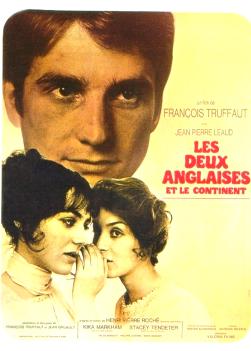Francois Truffaut‘s fine 1971 film, Two English Girls, seems intent to tell us that young men and women cannot be close friends, that personal sacrifice cannot withstand non-conjugal physical desire. Based on a novel by Henri Pierre Roche, just as Jules and Jim is, it revolves around two women (sisters) and one man, unlike the two men and one woman of Jules.
Stylistically Truffaut is probably a bit over-imaginative, but he also proves what an excellent eye he has. He gives us a likable overhead shot of Claude (the man) and Muriel (one of the women) atop a high hill with the tiny figure of Muriel’s sister Anne—before she disappears in an iris-out!—at the bottom of the hill. He provides a smart scene in which Muriel, a thirty-year-old virgin—circa 1900—has her full-cover 19th century apparel slowly removed from her by the aforementioned Claude, whom she loves. Standing at last with her attractive mammaries exposed, she virtually symbolizes all humanity poised before an era of gradual sexual freedom (and all its unfortunate consequences).
In an earlier review of Two English Girls, I said it is inferior to Jules and Jim. Not so. Girls is not tedious. It is sad, which indeed is connected to its real feeling for suffering (mostly Muriel’s). It remains what I called it earlier: guileless and humane. If I live to be very old, chances are I’ll read the novel.
(In French with English subtitles)



